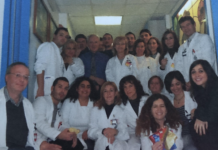Among the thousands of substances naturally found on earth, it is easy to find some that are radioactive. Radioactive materials are found in the soil, in the air, in our home walls, in our offices and even in food. We daily encounter these substances without realizing it, and experts that study this phenomenon call the sum of radiation to which a human is exposed natural background.
Radioactivity is a property of some unstable atomic nuclei that tend to modify themselves until they reach a stable state. This occurs through the emission of energy in the form of radiation. The physical phenomenon is known as radioactive decay, and the unstable atoms are called radionuclides.
The type of decay, energy and timing are specific characteristics of each radionuclide:
● half-life (T1/2) is defined as the time required for half of the initial atoms to have decayed. To give some examples in medicine, radionuclides with different half-life are used:
o short T1/2, such as Gallium-68 and Fluorine-18, which have T1/2 of 68 and 110 minutes;
o medium T1/2, such as Iodine-131 with a T1/2 of 8 days;
o long T1/2, such as Iridium-192 and Cobalt-60 with 74 days and 5 years.
● Type of radiation emitted. Depending on the type of decay we can have the emission of 4 different types of radiation: alpha particles, beta particles, gamma rays and neutrons. The energy of the emitted radiation depends on the decay itself.
Radionuclides with optimal decay characteristics are used in nuclear medicine for diagnostic or therapeutic purposes. For diagnostic purposes, radionuclides generally used are the ones with relatively short half-life (on the order of a few hours) and capable of emitting radiation that can be measured by a detector placed outside the human body (usually gamma rays). Technetium-99m and Fluorine-18 are two of the most widely used radionuclides. Typically, the radionuclide is chemically bound to a molecule for targeting it to body districts of specific interest for the study. This new compound is named radiopharmaceutical. An example is the binding between Fluorine-18 and sugar (specifically deoxyglucose) in the radiopharmaceutical FDG, which makes it possible to study cellular metabolism by exploiting the fact that metabolically active cells require more sugar and thus accumulate more radionuclide. We will go into more detail on this topic when we talk about PET.
For therapy purposes the aim is to use the emitted radiation to target cells in order to damage them or to reduce their proliferation. Again, radiopharmaceuticals are used that are specifically designed to accumulate as close as possible to the cells being treated. Whereas in diagnostics it is necessary for the radiation to be able to leave the body in order to be detected, in therapy the radiation will have to deposit its energy at a very short distance from the treated cells. For this reason, radionuclides used in therapy are those that emit radiation capable of travelling only short distances (a few mm maximum), just like low-energy beta, alpha and gamma rays. If the radionuclide used, such as Iodine-131 in the treatment of certain thyroid diseases, also emits radiation that exits the patient’s body, this can be used to verify the distribution of the drug in the body through external measurements.
Please Note‼ Radiopharmaceutical is not a contrast agent and therefore does not cause allergic reactions; it is tolerated even by those allergic to food, drugs, and contrast agents used in radiology.

Caption: Different radiopharmaceuticals are used for diagnostic or therapeutic purposes.



